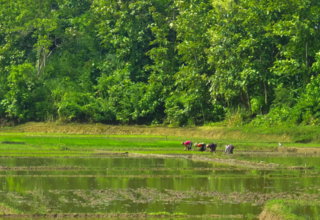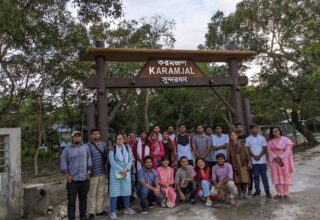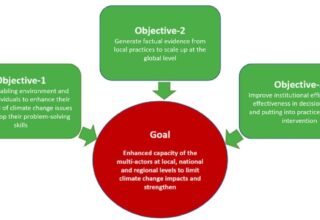(Originally published here)
Climate change poses a serious threat to the environment and people around the world. The Fifth Assessment Report of the Intergovernmental Panel on Climate Change (IPCC) has warned that, without adequate adaptation and mitigation measures, the world is likely to face severe and irreversible impacts of climate change in the form of extreme weather events, loss of bio-diversity, and food insecurity.
Despite being subject to adverse climate-induced effects, we have witnessed rapid economic growth across Asia, particularly in the last few decades.
However, this has subsequently brought a rise in energy consumption and unwelcome greenhouse gas (GHG) emissions. In 2005, Asia accounted for roughly 38% of global emissions. Considering the continuation of the region’s rapid economic growth, Asia’s emissions are likely to double by 2050 (IGES, 2014).
It is now paramount that low-carbon actions receive the necessary support to be mainstreamed into policies at the global, national, and local levels. By shifting towards low-carbon development, Asia can mitigate its own vulnerabilities and help stabilise climate change.
LoCARNet – IGES Partnership
Considering the significance of the formulation and implementation of science-based policies for low-carbon development in the Asian region, an open network of researchers, research organisations, as well as like-minded relevant stakeholders — the Low Carbon Asia Research Network (LoCARNet) was launched at the East Asia Low Carbon Growth Partnership Dialogue in 2012.
As a knowledge-sharing network, LoCARNet reflects an awareness of the importance of facilitating the realisation of a low-carbon and sustainable society.
The Institute for Global Environmental Strategies (IGES) of Japan has been serving as the secretariat of the LoCARNet since 2012. The secretariat works in co-operation with Japan’s National Institute for Environmental Studies (NIES), the Japan focal point of this network, to promote dialogue among researchers and policy-makers in Asian developing countries.
The goal of LoCARNet is to encourage and enable Asian developing countries to strengthen their climate and energy policy-making through the use of their own scientific and research communities. For this, LoCARNet emphasises quantitative tools and modelling approaches that can be used for promoting an integrated knowledge-based system.
Carbon Emission Pathways for Bangladesh
In continuation with its activities in Asia, LoCARNet has prioritised Bangladesh as one of the target countries for initiating capacity building for science-based climate policymaking.
Whilst addressing the need to adapt to a changing environment, Bangladesh must also look to form climate policies which steer towards low-carbon development, not just because the country is set to see rapid growth, but also to set a precedent for other developing nations and developed nations to do their part.
To start this thinking on low carbon development, a one-day policy dialogue on “Carbon Emission Pathways for Bangladesh” was held in Dhaka on January 24. The event brought together policy-makers, researchers, academics who demonstrated discussed possible analytical methodologies and quantitative tools for policy-making for low carbon development.
The event was organised by IGES, in collaboration with the International Centre for Climate Change and Development (ICCCAD) and focused on two thematic sessions:
Updating climate change related policies, activities, and research in Bangladesh
This session focused on the existing climate change-related policies and their implementation in Bangladesh, the status of research on environment and climate change from an academic perspective, the role of the civil society in climate policy-making and identifying the gaps in building synergy between research and policy-making.
Science-based research and integrated climate policy
Science-based methods for analysing energy and emissions were discussed in detail. Along with overall integrated models, country-specific quantitative tools such as the newly-developed Bangladesh 2050 Pathways Calculator and Japan 2050 Low Carbon Navigator were demonstrated. The session also hosted a presentation on low-carbon technology assessment and diffusion-related activities between Japan and Bangladesh.
The policy dialogue had a special presentation on low carbon technology assessment in Bangladesh. This is an IGES project funded by the Ministry of the Environment of Japan. The project aims at promoting low carbon technologies in Bangladesh and at creating possible opportunities for joint investment projects in the low carbon technology area.
The Bangladesh 2050 Energy and Emissions Pathways Calculator
Acknowledging the need for data-driven climate forecasts, an integrated model of energy, emissions, and land-use in Bangladesh has been developed to identify energy secure pathways for supply and demand of energy between now and 2050.
The project, developed by a team of researchers at Cardiff University and funded by the UK Department of Energy and Climate Change (DECC), was demonstrated at the policy dialogue as was the Japanese version of the tool known as the Japan 2050 Low Carbon Navigator.
The Bangladesh 2050 Calculator compiles a huge scientific database into one single system and then outputs results in easily-interpretable graphs. “The calculator allows the user to explore all high-level energy, economic, and emission pathway options that the country faces. For each possible pathway, the user can investigate likely impacts on land-use, electricity, energy security, food production, and intake.”
There are currently two versions of the calculator; one is simplified and user-friendly and the other more detailed with the underlying data accessible. The latter may be more suited for policy-makers and also to inform local educators of the effectiveness of their interventions.
The simplified version of the calculator adopts a user-friendly interface, eliminating all the technical jargon, and is available as an open-source web tool: http://www.bd2050.org.
The way forward
Good practices and examples of scientific methodologies from other countries are likely to help relevant stakeholders initiate dialogue and discussions, which is an essential step in low carbon transformation of any country. In many countries, particularly developing ones, the levels of knowledge and capacity can vary quite significantly among policy-makers, researchers, practitioners, and other stake-holders. This is especially true for the carbon emissions sector, which is relatively intangible compared to other developmental activities.
Therefore, partnerships and research-based collaboration such as that between the Institute for Global Environmental Strategies (IGES) in Japan, together with the International Centre for Climate Change and Development (ICCCAD) at the Independent University, Bangladesh (IUB) are critical to safeguarding the future of Bangladesh.
Free-to-attend Bangladesh 2050 Pathways Workshops
Engaging the public, stake-holders, and the government of Bangladesh is a vital step to ensure that the future of Bangladesh is one where the level of pollution and emissions are controlled.
A series of free-to-attend ‘Bangladesh 2050 Pathways Workshops’ are to be held in Dhaka from February to March. More information can be found at https://www.icccad.net/upcoming-events/.
Written by: Alex Trowell, Visiting Researcher, ICCCAD and Mustafa Moinuddin, Senior Policy Researcher, IGES






